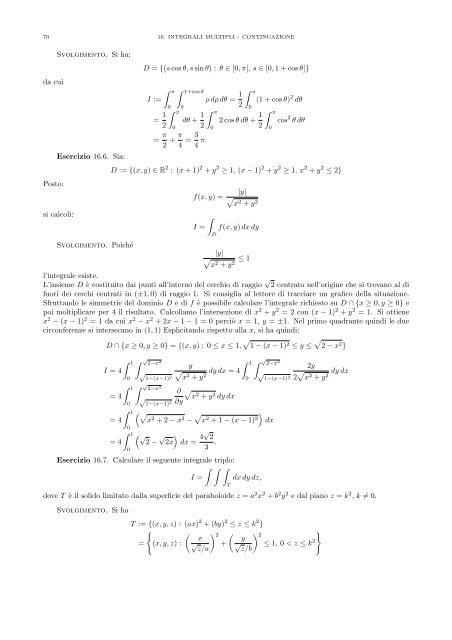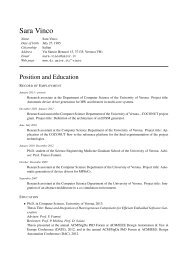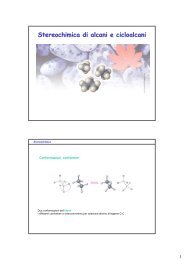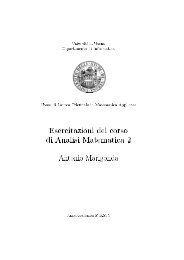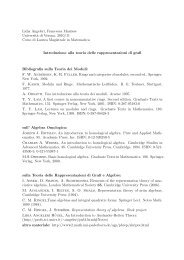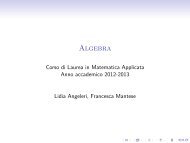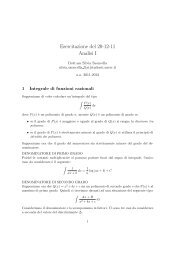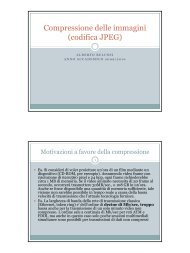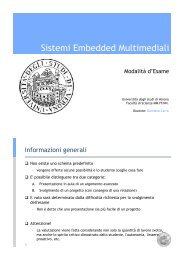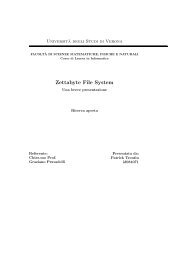You also want an ePaper? Increase the reach of your titles
YUMPU automatically turns print PDFs into web optimized ePapers that Google loves.
70 16. INTEGRALI MULTIPLI - CONTINUAZIONE<br />
da cui<br />
Posto:<br />
Svolgimento. Si ha:<br />
Esercizio 16.6. Sia:<br />
si calcoli:<br />
Svolgimento. Poiché<br />
D = {(s cos θ, s sin θ) : θ ∈ [0, π], s ∈ [0, 1 + cos θ]}<br />
π 1+cos θ<br />
π<br />
I :=<br />
ρ dρ dθ =<br />
0 0<br />
1<br />
(1 + cos θ)<br />
2 0<br />
2 dθ<br />
= 1<br />
π<br />
dθ +<br />
2 0<br />
1<br />
π<br />
2 cos θ dθ +<br />
2 0<br />
1<br />
π<br />
cos<br />
2 0<br />
2 θ dθ<br />
= π π 3<br />
+ =<br />
2 4 4 π.<br />
D := {(x, y) ∈ R 2 : (x + 1) 2 + y 2 ≥ 1, (x − 1) 2 + y 2 ≥ 1, x 2 + y 2 ≤ 2}<br />
f(x, y) =<br />
<br />
I =<br />
D<br />
|y|<br />
x 2 + y 2<br />
f(x, y) dx dy<br />
|y|<br />
≤ 1<br />
x2 + y2 l’integrale esiste.<br />
L’insieme D è cost<strong>it</strong>u<strong>it</strong>o dai punti all’interno del cerchio di raggio √ 2 centrato nell’origine che si trovano al di<br />
fuori dei cerchi centrati in (±1, 0) di raggio 1. Si consiglia al lettore di tracciare un grafico della s<strong>it</strong>uazione.<br />
Sfruttando le simmetrie del dominio D e di f è possibile calcolare l’integrale richiesto su D ∩ {x ≥ 0, y ≥ 0} e<br />
poi moltiplicare per 4 il risultato. Calcoliamo l’intersezione di x 2 + y 2 = 2 con (x − 1) 2 + y 2 = 1. Si ottiene<br />
x 2 − (x − 1) 2 = 1 da cui x 2 − x 2 + 2x − 1 − 1 = 0 perciò x = 1, y = ±1. Nel primo quadrante quindi le due<br />
circonferenze si intersecano in (1, 1) Esplic<strong>it</strong>ando rispetto alla x, si ha quindi:<br />
D ∩ {x ≥ 0, y ≥ 0} = {(x, y) : 0 ≤ x ≤ 1, 1 − (x − 1) 2 ≤ y ≤ 2 − x 2 }<br />
I = 4<br />
= 4<br />
= 4<br />
= 4<br />
1 √ 2−x2 √<br />
0 1−(x−1) 2<br />
1 √ 2−x2 0<br />
1<br />
0<br />
1<br />
0<br />
y<br />
dy dx = 4<br />
x2 + y2 1 √ 2−x2 0<br />
√ 1−(x−1) 2<br />
∂ <br />
√ x2 + y2 dy dx<br />
1−(x−1) 2 ∂y<br />
<br />
x2 + 2 − x2 − x2 + 1 − (x − 1) 2 dx<br />
√ √ <br />
2 − 2x dx = 4√2 3 .<br />
Esercizio 16.7. Calcolare il seguente integrale triplo:<br />
<br />
I = dx dy dz,<br />
T<br />
2y<br />
2 x2 dy dx<br />
+ y2 dove T è il solido lim<strong>it</strong>ato dalla superficie del paraboloide z = a 2 x 2 + b 2 y 2 e dal piano z = k 2 , k = 0.<br />
Svolgimento. Si ha<br />
T := {(x, y, z) : (ax) 2 + (by) 2 ≤ z ≤ k 2 }<br />
2 2 x<br />
y<br />
= (x, y, z) : √z/a + √z/b ≤ 1, 0 < z ≤ k 2


